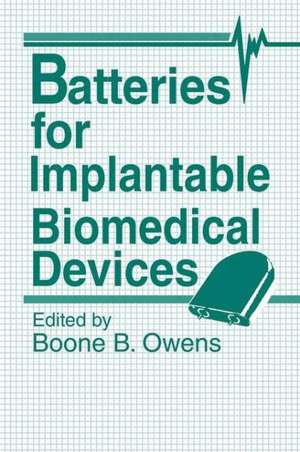Batteries for Implantable Biomedical Devices
Editat de B.B. Owensen Limba Engleză Paperback – 2 iun 2012
Preț: 643.84 lei
Preț vechi: 757.46 lei
-15% Nou
Puncte Express: 966
Preț estimativ în valută:
123.20€ • 128.95$ • 102.54£
123.20€ • 128.95$ • 102.54£
Carte tipărită la comandă
Livrare economică 31 martie-14 aprilie
Preluare comenzi: 021 569.72.76
Specificații
ISBN-13: 9781468490473
ISBN-10: 1468490478
Pagini: 384
Ilustrații: 380 p. 81 illus.
Dimensiuni: 152 x 229 x 20 mm
Greutate: 0.51 kg
Ediția:Softcover reprint of the original 1st ed. 1986
Editura: Springer Us
Colecția Springer
Locul publicării:New York, NY, United States
ISBN-10: 1468490478
Pagini: 384
Ilustrații: 380 p. 81 illus.
Dimensiuni: 152 x 229 x 20 mm
Greutate: 0.51 kg
Ediția:Softcover reprint of the original 1st ed. 1986
Editura: Springer Us
Colecția Springer
Locul publicării:New York, NY, United States
Public țintă
ResearchCuprins
1. Electrically Driven Implantable Prostheses.- 1. General Background.- 2. Devices Background.- 3. Business Aspects.- 4. Future Directions.- References.- 2. Key Events in the Evolution of Implantable Pacemaker Batteries.- 1. Introduction.- 2. An Interview with Samuel Ruben.- 3. An Interview with Wilson Greatbatch.- References.- 3. Lithium Primary Cells for Power Sources.- 1. Introduction.- 2. The Elements of a Battery.- 3. Battery Parameters.- 4. Battery Performance.- 5. Microcalorimetry.- 6. Implantable Battery Chemistries.- References.- 4. Evaluation Methods.- 1. Evaluation Objectives.- 2. Accelerated Testing.- 3. Nonaccelerated Testing.- 4. Qualification Protocol.- 5. Data Analysis.- References.- 5. Battery Performance Modeling.- 1. Description of the Problem.- 2. Importance of the Solution.- 3. Description of the Variables and Relationships.- 4. Classification of Models.- 5. Statistical Methods.- 6. Modeling of the Lithium/Iodine Pacemaker Battery.- 7. Device Longevity.- 8. Conclusion.- References.- 6. Lithium/Halogen Batteries.- 1. Introduction.- 2. General Features of Lithium/Halogen Solid Electrolyte Batteries.- 3. The Lithium/Bromine System.- 4. Chemistry of the Lithium/Iodine-Poly vinylpyridine System.- 5. Construction of Lithium/Iodine-PVP Cells.- 6. Discharge Characteristics of the Li/I2-PVP Battery.- 7. Performance of the Li/I2-PVP Cell.- 8. Summary and Conclusion.- References.- 7. Lithium Solid Cathode Batteries for Biomedical Implantable Applications.- 1. Introduction.- 2. General Features of Lithium Solid Cathode Systems.- 3. Specific Systems Used for Biomedical Applications.- 4. Use of Lithium Solid Cathode Systems in Implanted Medical Devices.- 5. Summary and Conclusions.- References.- 8. Lithium-Liquid Oxidant Batteries.- 1. Introduction.- 2. Description of the System.- 3. Capacity and Energy Density.- 4. State-of-Discharge Indication.- 5. Voltage Delay.- 6. Safety.- References.- 9. Mercury Batteries for Pacemakers and Other Implantable Devices.- 1. Background.- 2. Chemistry.- 3. Cell Design and Performance Characteristics.- References.- 10. Rechargeable Electrochemical Cells as Implantable Power Sources.- 1. Introduction.- 2. Nickel Oxide/Cadmium Cells.- 3. Rechargeable Mercuric Oxide/Zinc Cells.- 4. Prospects for Future Use of Rechargeable Cells.- References.- 11. Nuclear Batteries for Implantable Applications.- 1. General Description of Nuclear Batteries.- 2. Isotope Selection.- 3. Detailed Characteristics of the Plutonium-238 Isotope.- 4. Thermoelectric Generator Systems.- 5. Thermopile Design.- 6. Insulation Design and Selection.- 7. Fuel Capsule Design.- 8. Thermal Analysis.- 9. Electrical Characteristics.- 10. Radiation Effects.- 11. Licensing Requirements.- 12. Applications of Nuclear Batteries.- 13. Nuclear Battery Reliability.- References.











